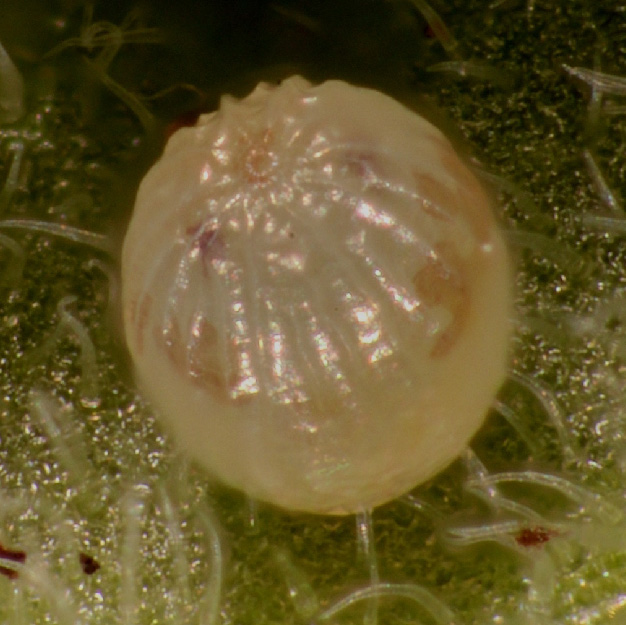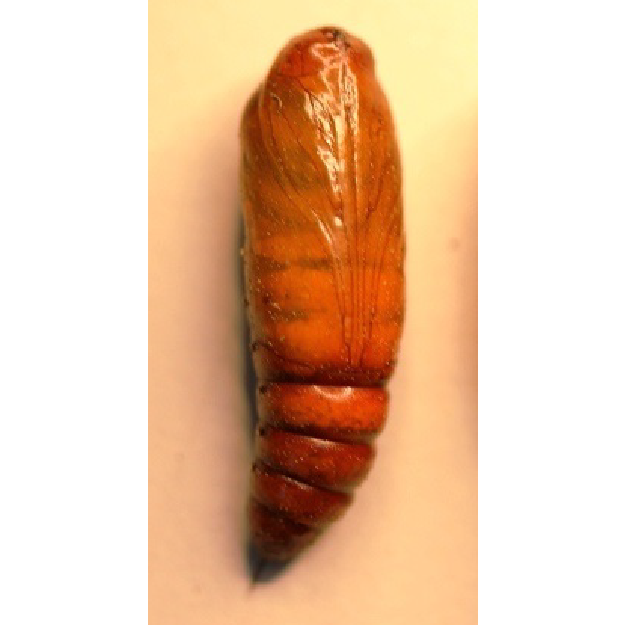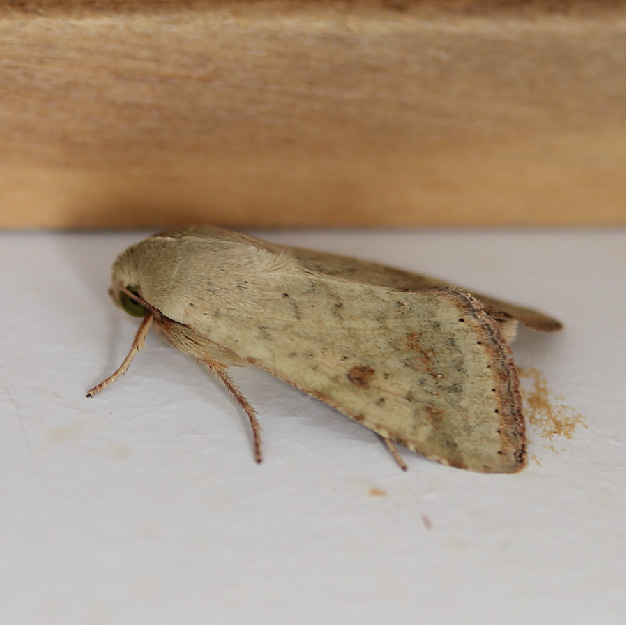Cotton bollworm
Helicoverpa armigera
Appearance
The eggs of the cotton boll owl are cream colored and are laid singly or in smaller groups. They are spherical with a diameter of about 0.5 mm and show a finely chiseled surface. To the best of our current knowledge, they cannot be distinguished from the eggs of related species and are very difficult to see with the naked eye.
The cotton bollworm is a very variably colored caterpillar. In addition to green, there are reddish to brownish color varieties. Characteristic are the longitudinal bands resolved into fine lines as well as bristles standing on strongly hardened (sclerotized) bases. The body skin is covered with very fine cones that require a magnifying glass to identify. To obtain certainty for identification, the caterpillar must be bred on to the moth.
The wings of cotton chapweed owl butterflies are extremely variably colored in a wide range of browns (females) and grays (males) and have a wingspan of about 35 mm.
Biology
The cotton bollworm(Helicoverpa armigera) is the caterpillar of a nocturnal butterfly that belongs to the owl family (Noctuidae).
Cotton boll owls lay eggs on their host plants usually near flowers or fruits. Females can lay over 1000 eggs depending on the nutritional status of the caterpillar from which they had developed. In the course of development, six caterpillar stages are passed through. The caterpillars prefer to feed in flowers, shoot tips or fruits. If they have the opportunity, they bore into plant parts and then stay in the feeding tunnels. The ripening seeds are preferred as food. To pupate, the caterpillar leaves its host plant and digs a small burrow, which it lines with spider silk and in which it pupates. Depending on the temperature, several generations of moths may develop each season.
Damage symptoms
Typical symptoms are boreholes and feeding tunnels in vegetable fruits and various seed stalks, but also in flowers or buds. There is contamination by fecal crumbs and rotting caused by secondary pathogens.

Host plants
In Austria, the caterpillars have so far been found in fruits of nightshade plants (peppers, tomatoes, melanzani), on bush beans, artichokes, cucumber shoot tips, corn on the cob as well as in lettuce, gerbera and geranium flowers.
Worldwide, it is most notorious for its infestation of cotton bolls, which is where its German name comes from.
However, its entire host plant list includes more than 120 wild and cultivated plants, and one of its preferred host plants is corn.
Distribution
The cotton bollworm is widespread in the tropics and subtropics of Asia, Africa, America and Oceania. In Europe, it is common in the Mediterranean region and is also already present to some extent in temperate climate regions.
In Austria, especially in the marginal areas of the Pannonian Plain, the cotton bollworm occurs annually, especially in very hot years mass occurrences may occur.
Please refer to the monitoring map of the Austrian Chamber of Agriculture which is prepared in cooperation with us.
Propagation and transmission
Hibernation in the dormant stage as a pupa is possible in dry, not too cold soils. In addition, the butterfly can fly very well and is able to cover greater distances of up to 1,000 km with the help of wind drift. Thus, it can penetrate from the south far into the north of Europe in summer.
Economic importance
The feeding activity of the caterpillars severely devalues fruits, buds or seeds. This can result in considerable yield losses due to a reduction in the quality of the infested fruit. Damage has so far been observed in arable crops (corn) and outdoor vegetables (lettuce, bush beans, artichokes), but also in glasshouse crops (tomatoes, peppers, melanzani, ...). Damage was also observed in allotment gardens.
Prevention and control
- Before the start of cultivation, the absence of infestation in the greenhouse and foil tunnel should be checked by specific pheromone traps. Carry out regular infestation checks during the season.
- Before and after the start of cultivation, carry out intensive soil cultivation in the greenhouse and foil tunnel. Only purchase young plants that are free of infestation.
- In case of persistent infestation in greenhouses and foil tunnels, keep the soil very moist during winter: this simple measure affects overwintering of the drought-loving species.
- Treatment with an approved, effective plant protection product against free-feeding butterfly caterpillars or owl caterpillars (see list of plant protection products approved in Austria).
- Use of approved biological plant protection products: Bacillus thuringiensis var. aizawai and kurstaki and/or a nucleopolyhedrovirus preparation against young caterpillars. Control of young caterpillars must be carried out before they bore into the fruit/buds.
- Use of natural antagonists: in vegetable production under glass, the periodic release of egg parasites of the genus Trichogramma has worked well.
Specialized information
Diagnosis
For reliable identification of the cotton chapweed owl it is necessary to examine the genital tract of the moths:
In the male, typical chitinous horns (cornuti) can be found inside, while in the female, a vesicular receptaculum seminis is visible next to the spirally twisted intestine, which is covered with fine denticles arranged in four longitudinal grooves.

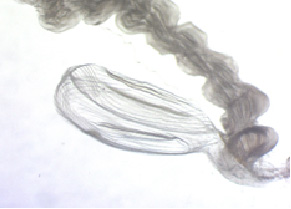
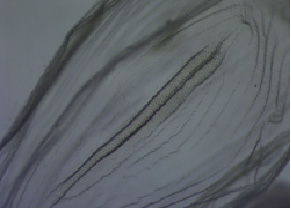
Last updated: 12.09.2024
automatically translated
